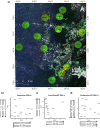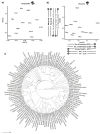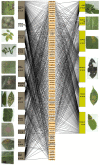Linking Anthropogenic Landscape Perturbation to Herbivory and Pathogen Leaf Damage in Tropical Tree Communities
- PMID: 38005736
- PMCID: PMC10675074
- DOI: 10.3390/plants12223839
Linking Anthropogenic Landscape Perturbation to Herbivory and Pathogen Leaf Damage in Tropical Tree Communities
Abstract
Anthropogenic disturbance of tropical humid forests leads to habitat loss, biodiversity decline, landscape fragmentation, altered nutrient cycling and carbon sequestration, soil erosion, pest/pathogen outbreaks, among others. Nevertheless, the impact of these alterations in multitrophic interactions, including host-pathogen and vector-pathogen dynamics, is still not well understood in wild plants. This study aimed to provide insights into the main drivers for the incidence of herbivory and plant pathogen damage, specifically, into how vegetation traits at the local and landscape scale modulate such interactions. For this purpose, in the tropical forest of Calakmul (Campeche, Mexico), we characterised the foliar damage caused by herbivores and pathogens in woody vegetation of 13 sampling sites representing a gradient of forest disturbance and fragmentation in an anthropogenic landscape from well preserved to highly disturbed and fragmented areas. We also evaluated how the incidence of such damage was modulated by the vegetation and landscape attributes. We found that the incidence of damage caused by larger, mobile, generalist herbivores, was more sensitive to changes in landscape configuration, while the incidence of damage caused by small and specialised herbivores with low dispersal capacity was more influenced by vegetation and landscape composition. In relation to pathogen symptoms, the herbivore-induced foliar damage seems to be the main factor related to their incidence, indicating the enormous importance of herbivorous insects in the modulation of disease dynamics across tropical vegetation, as they could be acting as vectors and/or facilitating the entry of pathogens by breaking the foliar tissue and the plant defensive barriers. The incidence of pathogen damage also responded to vegetation structure and landscape configuration; the incidence of anthracnose, black spot, and chlorosis, for example, were favoured in sites surrounded by smaller patches and a higher edge density, as well as those with a greater aggregation of semi-evergreen forest patches. Fungal pathogens were shown to be an important cause of foliar damage for many woody species. Our results indicate that an increasing transformation and fragmentation of the tropical forest of southern Mexico could reduce the degree of specialisation in plant-herbivore interactions and enhance the proliferation of generalist herbivores (chewers and scrapers) and of mobile leaf suckers, and consequently, the proliferation of some symptoms associated with fungal pathogens such as fungus black spots and anthracnose. The symptoms associated with viral and bacterial diseases and to nutrient deficiency, such as chlorosis, could also increase in the vegetation in fragmented landscapes with important consequences in the health and productivity of wild and cultivated plant species. This is a pioneering study evaluating the effect of disturbances on multitrophic interactions, offering key insights on the main drivers of the changes in herbivory interactions and incidence of plant pathogens in tropical forests.
Keywords: anthropic disturbance; herbivory damage; multitrophic interactions; plant-pathogen damage; tropical humid forest.
Conflict of interest statement
The authors declare no conflict of interest.
Figures




Similar articles
-
Tropical forest loss and its multitrophic effects on insect herbivory.Ecology. 2016 Dec;97(12):3315-3325. doi: 10.1002/ecy.1592. Ecology. 2016. PMID: 27911998
-
Linking changes in landscape structure to insect herbivory in forest edges and interiors of Atlantic Forest remnants.Ecol Appl. 2024 Oct;34(7):e3026. doi: 10.1002/eap.3026. Epub 2024 Aug 27. Ecol Appl. 2024. PMID: 39192366
-
Effects of local tree diversity on herbivore communities diminish with increasing forest fragmentation on the landscape scale.PLoS One. 2014 Apr 17;9(4):e95551. doi: 10.1371/journal.pone.0095551. eCollection 2014. PLoS One. 2014. PMID: 24743315 Free PMC article.
-
Anthropogenic fragmentation of landscapes: mechanisms for eroding the specificity of plant-herbivore interactions.Oecologia. 2018 Jun;187(2):521-533. doi: 10.1007/s00442-018-4115-5. Epub 2018 Mar 21. Oecologia. 2018. PMID: 29560512 Review.
-
Combining paleo-data and modern exclosure experiments to assess the impact of megafauna extinctions on woody vegetation.Proc Natl Acad Sci U S A. 2016 Jan 26;113(4):847-55. doi: 10.1073/pnas.1502545112. Epub 2015 Oct 26. Proc Natl Acad Sci U S A. 2016. PMID: 26504223 Free PMC article. Review.
References
-
- Tylianakis J.M., Morris R.J. Ecological Networks Across Environmental Gradients. Annu. Rev. Ecol. Evol. Syst. 2017;48:25–48. doi: 10.1146/annurev-ecolsys-110316-022821. - DOI
-
- Silveira L.T., de Araújo W.S. Plant-Herbivore Networks Composed by Adult and Immature Insects Have Distinct Responses to Habitat Modification in Brazilian Savannas. J. Insect Conserv. 2021;25:747–758. doi: 10.1007/s10841-021-00340-9. - DOI
-
- Crawley M.J. Insect Herbivores and Plant Population Dynamics. Annu. Rev. Entomol. 1989;34:531–562. doi: 10.1146/annurev.en.34.010189.002531. - DOI
Grants and funding
LinkOut - more resources
Full Text Sources

